§ 6.7. Open Space Set-Asides.
A.
Purpose and Intent. Open space set-asides are intended for the use and enjoyment of a development's residents, employees, or users. Open space set-asides serve numerous purposes, including preserving natural resources, ensuring resident access to open areas and recreation, reducing the heat island effect of developed areas, enhancing stormwater management, and providing other public health benefits.
B.
Applicability.
1.
General. Unless exempted in accordance with paragraph 3 below, the standards in this section shall apply to all new development west of Interstate 95.
2.
Time of Review. Review for compliance with these standards shall occur at the time of review for any of the following applications for a development permit (as appropriate):
a.
Planned Development (see Section 3.4.F);
b.
Special Use Permit (see Section 3.4.G);
c.
Public or Semipublic Use Permit (See Section 3.4.H);
d.
Site Plan (see Section 3.4.I);
e.
Certificate of Appropriateness (see Section 3.4.J); or
f.
Building Permit (see Section 3.4.R).
3.
Exemptions. The following forms of development are exempt from the standards in this section:
a.
Agricultural uses;
b.
Single-family detached dwellings, duplexes, or mobile/manufactured homes on a lot in existence on March 1, 2015; and
c.
Development in Historic Overlay districts.
C.
Amount of Open Space Set Aside Required. Development subject to the standards in this section shall provide the minimum amounts of open space set-aside identified in Table 6.7.C: Required Open Space Set-Aside, based on the use classification.
Table 6.7.C: Required Open Space Set-Aside
Use Classification Minimum Open Space Set-Aside Area
(as percentage of development site area)Residential Uses 20% Institutional Uses 10% Commercial Uses and Mixed-Use Development 10% Industrial Uses 5% D.
Areas Counted as Open Space Set-Aside. The features and areas identified in Table 6.7.D, Open Space Set-Aside Features, shall be credited towards compliance with the open space set-aside standards of this section:
Table 6.7.D: Open Space Set-Aside Features
Area Counted as Common Open
Space Set-Asides
Description
Design and Maintenance
Requirements
Natural Features
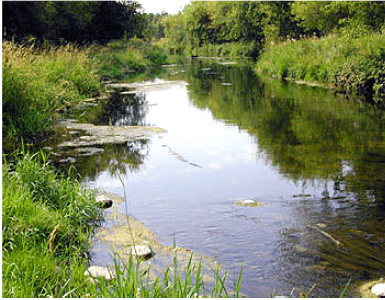
Natural water features (including lakes, ponds, rivers, streams, rivers, wetlands, and drainageways), flood hazard areas, and important wildlife habitat areas Preservation of any existing natural features shall have highest priority for locating open space set-asides.
Maintenance is limited to the minimum removal and avoidance of hazards, nuisances, or unhealthy conditions.Active Recreational Areas
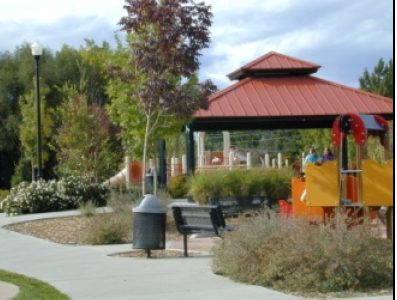
Land occupied by areas and facilities used for active recreational purposes, such as pools, playgrounds, tennis courts, jogging trails, ball fields, and clubhouses Active recreational areas may occupy up to 100 percent of the open space set-aside (if no natural features exist on the site), and shall occupy no less than 40 percent of the total open space set-aside area within a residential development.
And shall be compact and contiguous unless used to link or continue an existing or planned open space resource.
Areas shall abut at least one street, if reasonably practical.Formal Plantings and Gardens
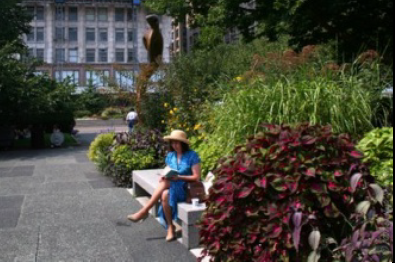
Formally planned and regularly maintained open areas that provide passive recreation opportunities, including arranged plantings, gardens, gazebos, and similar structures, as well as roof gardens Formal plantings and gardens shall have at least one direct access street, and be oriented to surrounding development. Squares, Forecourts, Plazas, and Parks

Squares, forecourts, plazas, and parks that provide active and passive recreational opportunities and help create special places Such features shall be at least 200 square feet, but no more than one acre, in area.
Such features shall have at least one direct access street.
Surrounding buildings shall be oriented toward the square, forecourt, plaza, or park when possible and a connection shall be made to surrounding development.Required Landscape Areas
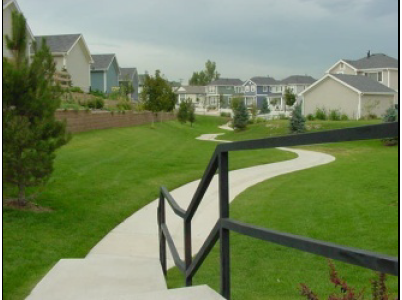
All areas occupied by required landscaping, perimeter buffers, and tree protection areas, except landscaped area within parking lots See landscaping standards (Section 6.4, Landscaping), perimeter buffer standards (Section 6.5), and tree preservation standards (Section 6.15.A). Stormwater Management Devices
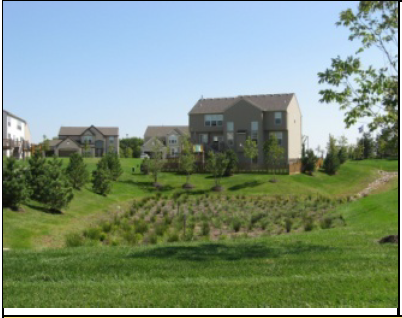
Up to 75 percent of the land area occupied by stormwater management devices (including retention and detention ponds and other bioretention devices), when such features are treated as an open space site amenity To qualify, stormwater management devices shall support passive recreation uses by providing access and pedestrian elements such as paths and benches Public Access Easements
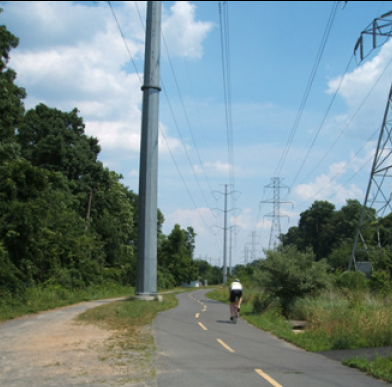
Public access easements (which often combine utility easements with paths or trails) that are available for passive recreational activities such as walking, running, and biking Such public access easements shall include at least one improved access from a public sidewalk, street, trail, or easement that includes signage designating the access point. E.
Areas Not Counted as Open Space Set-Aside. The following areas shall not be counted as open space set-aside:
1.
Private yards not subject to an open space or conservation easement;
2.
Street rights-of-way or private access easements, including sidewalks located within those rights-of-way or easements;
3.
Open parking areas and driveways for dwellings;
4.
Land covered by structures not designated for active recreational uses;
5.
Designated outdoor storage areas; and
6.
Stormwater ponds, unless located and designed as a site amenity (e.g., with low fencing, vegetative landscaping, gentle slopes, fountain or other visible water circulation device, and pedestrian access or seating).
F.
Design Standards for Open Space Set-Asides. Land used as an open space set-aside shall meet the following design standards:
1.
Location. Open space shall be located so as to be readily accessible and useable by occupants and users of the development. Where possible, a portion of the open space set-aside should provide focal points for the development through prominent placement or easy visual access from streets.
2.
Configuration.
a.
Open space lands shall be compact and contiguous unless a different configuration is needed to continue an existing trail or accommodate preservation of natural features.
b.
If the development site is adjacent to existing or planned trails, parks, or other public open area land, the open space set-aside shall, to the maximum extent practicable, be located to adjoin, extend, and enlarge the trail, park, or other open area land.
c.
If a passive recreation open space set-aside area with a minimum width of twenty feet or more abuts an existing or planned open space area, no perimeter buffer (Section 6.6, Perimeter Buffers) shall be required between the two open space areas.
3.
Orientation of Adjacent Buildings. Buildings adjacent to required open space set-asides shall have at least one entrance facing the open space set-aside.
4.
Prioritization of Open Space Set-Aside. To the maximum extent practicable, open space set-asides shall be located and organized to include, protect, or enhance as many of the following open areas and features as possible:
a.
Natural features such as riparian areas, flood hazard areas, and important wildlife habitat areas;
b.
Water features such as drainages, canals, ditches, lakes, natural ponds, and retention and detention ponds;
c.
Protected trees and other mature trees;
d.
Perimeter buffers or visual transitions between different types or intensities of uses;
e.
Natural or geologic hazard areas or soil conditions, such as or floodplains and expansive soils; and
f.
Areas that accommodate multiple compatible open space uses rather than a single use.
5.
Development in Open Space Set-Asides. Development within open space set-asides shall be limited to that appropriate to the purposes of the type(s) of area set aside as open space (see Table 6.7.D: Open Space Set-Aside Features). Where appropriate, such development may include, but is not limited to, walking, jogging, and biking paths or trails; benches or other seating areas; tables, shelters, grills, and other picnicking facilities; docks and other facilities for fishing; environmental education guides and exhibits; gazebos and other decorative structures; fountains or other water features; play structures for children; gardens or seasonal planting areas; pools; athletic fields and courts; and associated clubhouses.
G.
Ownership, Management, and Maintenance of Open Space Set-Asides.
1.
Open space set-asides shall be managed and maintained as permanent open space through one or more of the following options:
a.
Conveyance of open space set-aside areas to a property owners' or homeowners' association that holds the land in common ownership and will be responsible for managing and maintaining the land for its intended open space purposes; or
b.
Conveyance of open space set-aside areas to a third party beneficiary such as an environmental or civic organization that is organized for, capable of, and willing to accept responsibility for managing and maintaining the land for its intended open space purposes; or
c.
Establishment of easements on those parts of individually-owned lots including open space set-aside areas that require the areas to be managed consistent with the land's intended open space purposes and prohibit any inconsistent future development.
2.
All options involving private ownership of open space set-aside area shall include deed restrictions, covenants, or other legal instruments that ensure continued use of the land for its intended open space purposes and provide for the continued and effective management, operation, and maintenance of the land and facilities.
3.
Responsibility for managing and maintaining open space set-aside areas lies with the owner of the land comprising the areas. Failure to maintain open space set-aside areas in accordance with the approved development shall be a violation of this Code.

